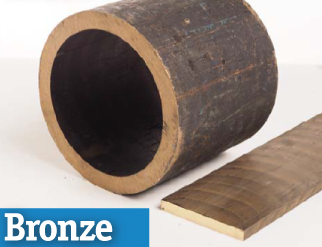Difference Between Copper, Brass And Bronze

Copper

Copper is used in a wide range of products due to its excellent electrical and thermal conductivity, good strength, good formability and resistance to corrosion. Pipe and pipe fittings are commonly manufactured from these metals due to their corrosion resistance. They can be readily soldered and brazed, and many can be welded by various gas, arc and resistance methods. They can be polished and buffed to almost any desired texture and luster.
There are grades of unalloyed Copper, and they can vary in the amount of impurities that are contained. Oxygen-free copper grades are used specifically in functions where high conductivity and ductility are needed.
One of the most important properties of copper is its ability to fight bacteria. After extensive antimicrobial testing by the Environmental Protection Agency, it was found that 355 copper alloys, including many brasses, were found to kill more than 99.9% of bacteria within two hours of contact. Normal tarnishing was found not to impair antimicrobial effectiveness.
Copper Applications
Copper was one of the earliest metals discovered. The Greeks and Romans made it into tools or adornments, and there are even historical details showing the application of copper to sterilize wounds and purify drinking water. Today it is most commonly found in electrical materials such as wiring because of its ability to effectively conduct electricity.
Brass
.png)
Brass is mainly an alloy that consists of copper with zinc added. Brasses can have varying amounts of zinc or other elements added. These varying mixtures produce a wide range of properties and variation in color. Increased amounts of zinc provide the material with improved strength and ductility. Brass can range in color from red to yellow depending on the amount of zinc added to the alloy.
- If the zinc content of the brass ranges from 32% to 39%, it will have increased hot-working abilities but the cold-working will be limited.
- If the brass contains over 39% zinc (example – Muntz Metal), it will have a higher strength and lower ductility (at room temperature).
Brass Applications
Brass is commonly used for decorative purposes primarily because of its resemblance to gold. It is also a commonly used to make musical instruments due to its high workability and durability.
Other Brass Alloys
Tin Brass
This is an alloy that contains copper, zinc and tin. This alloy group would include admiralty brass, naval brass and free machining brass. The tin has been added to inhibit dezincification (the leaching of zinc from brass alloys) in many environments. This group has low sensitivity to dezincification, moderate strength, high atmospheric and aqueous corrosion resistance and excellent electrical conductivity. They possess good hot forgeability and good cold formability. These alloys are typically used to make fasteners, marine hardware, screw machine parts, pump shafts and corrosion-resistant mechanical products.
Bronze

Bronze is an alloy that consists primarily of copper with the addition of other ingredients. In most cases the ingredient added is typically tin, but arsenic, phosphorus, aluminum, manganese, and silicon can also be used to produce different properties in the material. All of these ingredients produce an alloy much harder than copper alone.
Bronze is characterized by its dull-gold color. You can also tell the difference between bronze and brass because bronze will have faint rings on its surface.
Bronze Applications
Bronze is used in the construction of sculptures, musical instruments and medals, and in industrial applications such as bushings and bearings, where its low metal on metal friction is an advantage. Bronze also has nautical applications because of its resistance to corrosion.
Other Bronze Alloys
Phosphor Bronze (or Tin Bronze)
This alloy typically has a tin content ranging from 0.5% to 1.0%, and a phosphorous range of 0.01% to 0.35%. These alloys are notable for their toughness, strength, low coefficient of friction, high fatigue resistance, and fine grain. The tin content increases the corrosion resistance and tensile strength, while the phosphorous content increases the wear resistance and stiffness. Some typical end uses for this product would be electrical products, bellows, springs, washers, corrosion resistant equipment.
Aluminum Bronze
This has an aluminum content range of 6% – 12%, an iron content of 6% (max), and a nickel content of 6% (max). These combined additives provide increased strength, combined with excellent resistance to corrosion and wear. This material is commonly used in the manufacturing of marine hardware, sleeve bearings and pumps or valves that handle corrosive fluids.
Silicon Bronze
This is an alloy that can cover both brass and bronze (red silicon brasses and red silicon bronzes). They typically contain 20% zinc and 6% silicon. Red brass has high strength and corrosion resistance and is commonly used for valve stems. Red bronze is very similar but it has lower concentrations of zinc. It is commonly used in the manufacturing of pump and valve components.
Nickel Brass (or Nickel Silver)
This is an alloy that contains copper, nickel and zinc. The nickel gives the material an almost silver appearance. This material has moderate strength and fairly good corrosion resistance. This material is typically used to make musical instruments, food and beverage equipment, optical equipment, and other items where the aesthetics are an important factor.
Copper Nickel (or Cupronickel)
This is an alloy that can contain anywhere from 2% to 30% nickel. This material has a very high corrosion-resistance and has thermal stability. This material also exhibits a very high tolerance to corrosion cracking under stress and oxidation in a steam or moist air environment. Higher nickel content in this material will have improved corrosion resistance in seawater, and resistance to marine biological fouling. This material is typically used in making electronic products, marine equipment, valves, pumps and ship hulls.
CREDIT: MSKS IP Inc.
ORIGINAL FROM: https://www.metalsupermarkets.com/difference-between-copper-brass-bronze/
